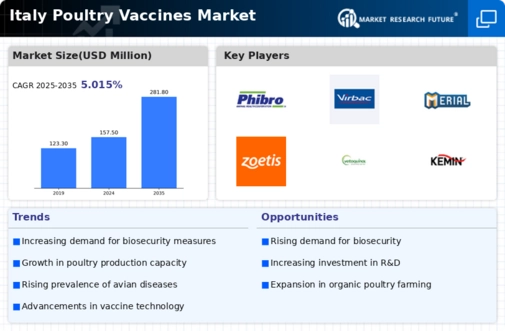Rising Demand for Poultry Products
The increasing consumption of poultry products in Italy is a primary driver for the poultry vaccines market. As the population grows and dietary preferences shift towards protein-rich foods, the demand for chicken and eggs rises. In 2023, poultry meat consumption in Italy reached approximately 1.5 million tonnes, reflecting a growth of around 3% from the previous year. This surge in demand necessitates enhanced biosecurity measures, including vaccination, to ensure healthy livestock and prevent disease outbreaks. Consequently, poultry producers are investing in vaccines to maintain production levels and meet consumer expectations. The poultry vaccines market is thus likely to expand as producers seek to protect their flocks and ensure a steady supply of poultry products.
Emerging Threats from Avian Diseases
The emergence of new avian diseases poses a significant challenge to the poultry industry in Italy, thereby driving the poultry vaccines market. Recent outbreaks of diseases such as avian influenza have raised concerns among producers and consumers alike. In response, there is an urgent need for effective vaccination strategies to mitigate the risks associated with these diseases. The Italian poultry vaccines market is expected to grow as producers invest in vaccines to protect their flocks from these emerging threats. With the potential for disease outbreaks to disrupt supply chains and impact food security, the focus on vaccination as a preventive measure is likely to intensify, further propelling the market forward.
Increased Awareness of Animal Health
There is a growing awareness among poultry farmers in Italy regarding the importance of animal health and welfare, which significantly impacts the poultry vaccines market. Farmers are increasingly recognizing that healthy birds lead to better productivity and profitability. This awareness has led to a shift in practices, with more producers adopting vaccination programs as a preventive measure against diseases. In 2024, it is estimated that around 70% of poultry farms in Italy will implement vaccination protocols, up from 55% in 2022. This trend indicates a robust commitment to animal health, which is likely to drive the poultry vaccines market as farmers seek effective solutions to protect their flocks and enhance overall farm performance.
Government Support and Funding Initiatives
Government initiatives aimed at supporting the poultry industry in Italy are contributing to the growth of the poultry vaccines market. Various funding programs and subsidies are being introduced to encourage farmers to adopt vaccination practices and improve biosecurity measures. In 2025, the Italian government allocated approximately €10 million to support vaccination campaigns against avian diseases, which is expected to enhance the overall health of poultry populations. This financial backing not only aids farmers in accessing necessary vaccines but also promotes awareness of their importance. As a result, the poultry vaccines market is likely to benefit from increased government support, fostering a healthier poultry sector and ensuring food safety for consumers.
Technological Innovations in Vaccine Development
Technological advancements in vaccine development are playing a crucial role in shaping the poultry vaccines market. Innovations such as recombinant vaccines and vector-based vaccines are becoming more prevalent, offering improved efficacy and safety profiles. In Italy, the adoption of these advanced vaccines is expected to increase, with market analysts projecting a growth rate of 5% annually over the next five years. These innovations not only enhance disease control but also reduce the need for antibiotics, aligning with the growing demand for sustainable farming practices. As poultry producers seek to leverage these technologies, the poultry vaccines market is likely to experience significant growth, driven by the need for effective and efficient vaccination solutions.



















Leave a Comment